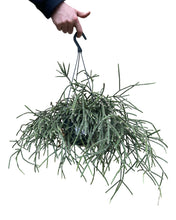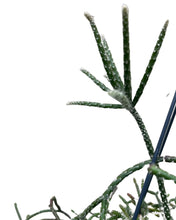Rhipsalis pilocarpa is part of the Cactaceae family and its native range is SE. Brazil (to Paraná). This plant is on the IUCN list as vulnerable, numbers are declining due to habitat loss and deforestation.
They have cylindrical pendant stems which are dark green to purple in colour and covered in fine hairs. Their flowers are very fragrant and bell-like in appearance. These plants grow under the shade of dense, overhanging tree branches in their natural environment.
Genus name comes from the Ancient Greek, meaning wicker work, this is in reference to the branches which appear to interlace as they hang. The specific epithet is from the Latin pilus meaning ‘hair’ and the Greek karpos meaning ‘fruit’, this is in reference to the bristle-like spines on the stems or fruit.
Light: Bright indirect light, meaning the plant sees the sun for 0-4 hours per day - this could be through trees or a translucent curtain, it’s important for the plant to see the sky in order to thrive. In its natural environment this plant would receive dappled light.
Water: With adequate light and a well draining potting mix, allow the top two inches to dry out before watering.
Potting mix: A well draining mix composed of coco coir, perlite or vermiculite, orchid bark and worm castings; you could also add some horticultural charcoal to this epiphytic mix.
Fertilising: Feed your plant with a cactus fertiliser every other watering during the growing season or when you observe active growth. You can dilute fertiliser to half the recommended amount but never add more.
Temperature: 18-24˚C.
Humidity: Rhipsalis would prefer higher humidity but do well to adapt to average home humidity. You can increase humidity by placing the plant on a watered pebble tray or using a humidifier.
Rhipsalis are non-toxic.





